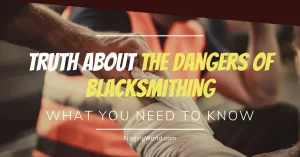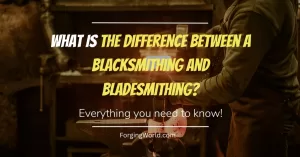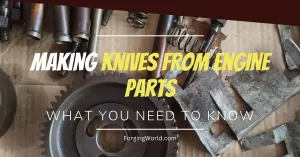Rebar is a very popular material for everyone just getting started in bladesmithing. One side of the industry is telling you that you should never use rebar for making blades while others are saying that you should, especially as a beginner. The main reason why so many beginners use rebar is that is it is easily available and cheap. However, is it good for knife making?
Rebar is not a good material for knife making since it is a mysterious material, meaning you don’t actually know what it is made from. When it comes to knives, this presents a huge problem as with improper heat treating, the blade can crack easily. Some knives made from rebar may turn out to be of decent quality while others may be useless.
There are several types of rebar, some of them are better suited for knife making while some aren’t. Undoubtedly you can heat it, make a knife-like shape and sharpen it, but its hardenability is questioned.
How to Test a Rebar for blacksmithing?
Rabar is used as a reinforcing bar made from a mixture of different materials. Most rebars are made from new steel, but others are rolled from old ones, such as railroad rails. By the American Society for Testing and Materials (ASTM), rebars should be identified with size number, the grade of rebar and its manufacturer but most of them are not.
When you buy new steel, you get all the required information and instructions on how to work with it. Rebar, on the other hand, is mysterious material, meaning you don’t know what is actually in it. Therefore, some tests could be done in order to establish a carbon content in a piece of rebar.
On the other hand, if you find rebar on a scrape yard or elsewhere, it is impossible to know its carbon content, whether is it low, medium or high. Identification of content is especially important when it comes to knife-making. Every good quality knife has to be properly heat treated. If you don’t understand the properties of the material you are working with, it would be impossible to do a proper heat treating.
SPARKING TEST
Sparking test is used for identifying metal made from scrap. It is a fast, convenient and easy test to do. In order to accomplish this, you don’t need some special, expensive equipment. All you need is some type of grinder, if possible a bench grinder. With bench grinder, it is easier to control the metal and get a nice steady stream of sparks.
Before starting this test, it would be good to go through some safety precautions:
- The grinder has to be properly installed
- When the grinder is on, you should stay on the side
- Wear safety glasses or face shield while using the grinder
- Keep your fingers away from the grinder
First, you need to prepare your grinder and workspace. The grinding wheel must be able to accomplish at least 23 m/s (4500 surface feet per minute) although the recommended speed is anywhere between 38-58 m/s (7500-11,500 sfpm). The workspace should be dark so you can properly estimate the sparks.
Later, you simply apply and hold the material on the grinder. You will soon figure out what pressure is needed to get a proper stream of sparks without reducing the speed of the grinder. Too much pressure increases the spark temperature which increases gives the appearance of a higher carbon content than is actually current.
The important spark characteristics to observe are color, number, and length of the sparks. Keep in mind that the length is highly dependent on the amount of pressure so it is extremely important to keep the same pressure. Instead of describing every characteristic for a different material, we provided you a picture that shows different length and numbers of sparks.
A friend of mine told me about the other potential way of determining carbon content in a piece of rebar. You simply look at the marks on the outside. Casting lines on the outside should be noticed. The more of this crossing lines rebar has, the higher carbon content it is.
Is Rebar Hardenable Steel?
Rebar is incredibly inconsistent to work with. With rebar you never know what to expect, some might even have enough carbon content, but not reliably. I remember one day when I made 5 knives out of the same rebar bar. The first piece held the edge nicely. The second one broke into several pieces when I dropped it. Others could not even harden at all. Five different outcomes from only one piece of rebar. With rebar, you never know what to expect because carbon content can vary from one spot in a rod to another.
Strength test of rebar you can see in this video where a comparison of 3 pieces of rebar was made. One was quenched in oil, the second one in water and the third one was only normalized. The strength test is performed by hammering the rebar which is clamped by the vise.
The one which was quenched in water cracked almost immediately without any bending. Rebar quenched in oil bent almost 90 degrees before snapping. Finally, the piece which was only normalized didn’t snap at all but bent completely.
If your plan is to use rebar for practicing, it is fine but in case you want to sell knives professionally, we would advise you to stay away from it. Also, the edges of the heat-treated rebar blades tend to be much sharper and more durable than the ones which are not heat treated.
Types of Rebar
Rebar can be found in many types, including:
- Carbon Steel Rebars
- European Rebar
- Galvanized Rebar
- Stainless Steel Rebar
- Epoxy-Coated Rebar
Carbon Steel Rebars are the most common type of rebar. It is known for its versatility but the downside is that it corrodes more easily.
European Rebar is much easier to bend because of their structure. It is primarily made from manganese which is known for its bending properties.
Galvanized rebar is known for its resistance to corrosion. It should be noted that you should NEVER use galvanized steel for knife-making. Zinc fumes which burned from it could seriously damage your lungs.
Stainless Steel Rebar is the most expensive rebar you can find. It is 1500 more resistant to corrosion than Carbon Steel Rebar. Using it for knife-making would be overkill.
Epoxy-Coated Rebars is basically a carbon steel rebar with an epoxy coat. They have similar textile strength but is much more resistant to corrosion.



